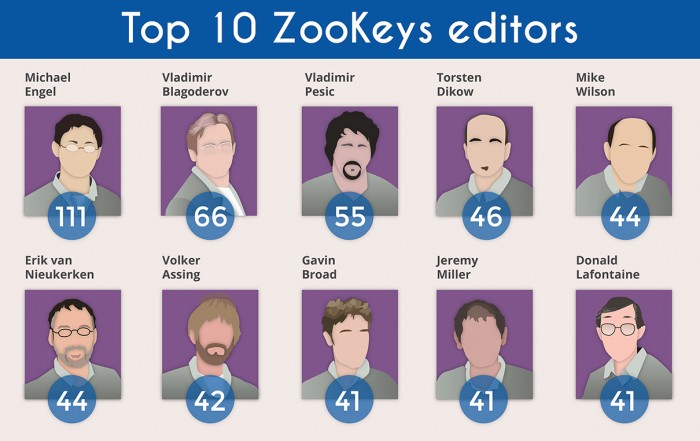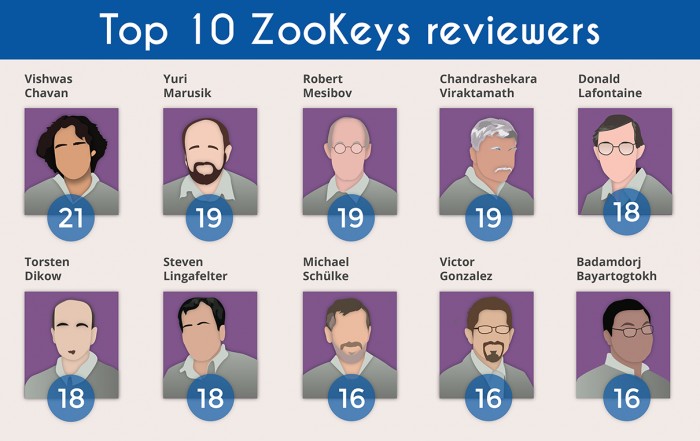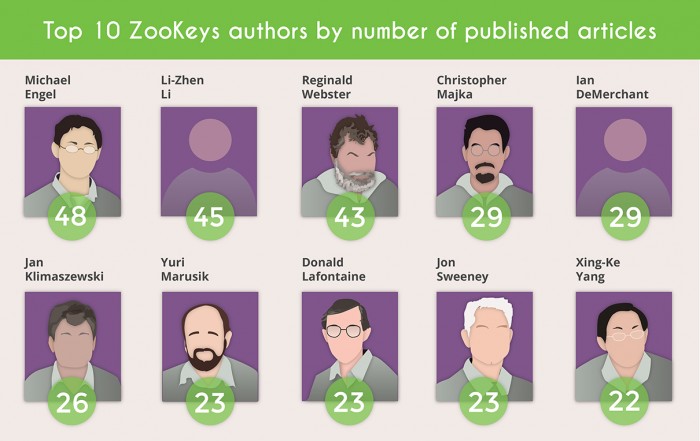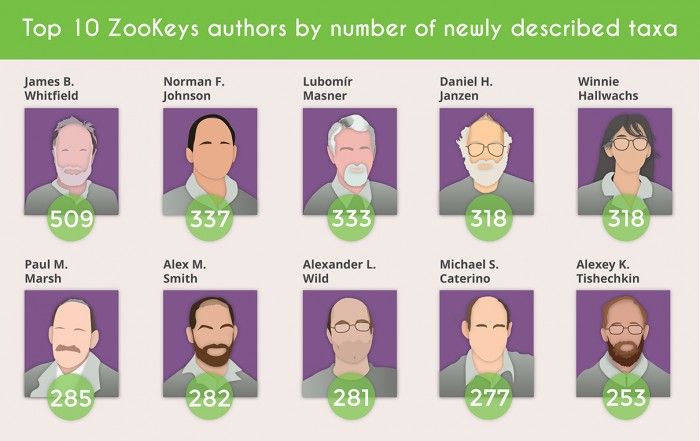When taxonomists discuss gender, they’re usually debating whether the etymological root of a species name is the same gender as the root of its genus, and whether that species name should end with –i, –a, or perhaps –us. While debating ancient Latin grammar may be a noble, if occasionally dull, pursuit, there’s a more important discussion on gender in taxonomy that we need to be having; why women continue to be underrepresented in our discipline.
I’ve been somewhat aware of the gender disparity in taxonomy for a while—I’ve casually noticed how few women are currently employed in natural history collections or as professors of taxonomy & systematics at universities, and that there are relatively few women attending taxonomic meetings, particularly outside of students and post-doc positions—but the issue burst into my consciousness like a slap to the face recently as the journal ZooKeys celebrated their 500th issue.
As a part of the celebration, ZooKeys created a series of Top 10 posters that they shared on social media, recognizing the editors, reviewers, and authors who have helped the journal become one of the most important venues for zoological taxonomy over the last 7 years. Check them out:
Of the 35 people being recognized for their contributions to publishing & the taxonomic process, in categories that are highly regarded and influential in hiring & promotion decisions, only 1 is a woman. I doubt ZooKeys could have created a starker depiction of gender disparity in taxonomy had they tried.
What’s going on here? How can only 1 woman be included in these lists? Hoping that it was some random fluke, I started looking around for more information on gender diversity in the taxonomic community, and well, it didn’t get better.
First, I looked at the editorial board & section editors for ZooKeys, and found only 1 woman sat on the editorial board, out of 15 members (6.7%), while only 37 of the 265 section editors were women (14%). When I compared this to Zootaxa, the other major publisher of zoological taxonomy, I found the exact same ratio among section editors, 14% (32/225). Systematic Biology? A slightly better 15 for 80 (19%), while Systematic Entomology is 3 for 18 (17%) and Cladistics is only 2 for 20 (10%). Even the small biodiversity journal for which I’m the technical editor only has 2 female editors out of 15 (13%). Meanwhile, the International Commission on Zoological Nomenclature, the governing body that sets the rules for naming animals and adjudicates disputes over names, currently has 23 male commissioners, and only 4 women (15%).
Compare this to ecology, where Timothée Poisot reports 24% of editors for the more than a dozen journals he’s looked at are women, while Cho et al. (2014) found editorial boards in other biological fields to be roughly 22% women in 2013 (up from ~8% in 1990). Clearly 22-24% is a far cry from parity, but it’s still 10% higher than it is in taxonomy.
But is this indicative of the true diversity of taxonomists? It’s hard to say. In 2010, the Canadian Expert Panel on Biodiversity Science surveyed taxonomists in Canada, and reported that 139 of their 432 survey respondents identified as women (30%). Ironically, the panel itself only included 3 women (out of 14; 21%), and only 2 women reviewers (out of 12; 17%), failing to accurately reflect the community it was attempting to assess. Meanwhile, the UK’s House of Lords Science and Technology committee on Taxonomy & Systematics (2008) reported only 143 of 861 UK taxonomists were women (17%), but while there was much discussion over the potential decline in total numbers of taxonomists, there was none regarding gender inequality.
Looking more broadly, 42% of science & engineering PhDs were awarded to women in 2013, and 28% of applicants to the NSF Division of Environmental Biology (the major funding source for ecology, evolutionary biology and taxonomy/systematics in the USA) in 2014 were women, so it’s not unreasonable to assume the professional taxonomic community is at least 25% women, and hopefully much higher. Again, 25% is a long ways from equality, but it still suggests there is a definite misrepresentation of diversity on the editorial committees of taxonomic journals.
So why does it matter if editorial boards and reviewer pools aren’t representative of the community, whether it be in terms of gender or ethnicity (another important discussion the taxonomic community should be having)? Well, for one, keeping taxonomic publishing an Old Boys Club is more likely to result in situations like that which recently occurred at PLoS ONE, with biased, sexist, and misogynistic attitudes influencing not only the publication of research, but by extension, the career advancement (or lack thereof) for taxonomists based solely on their gender. Now, I’m not saying that the editors and reviewers for ZooKeys & Zootaxa are explicitly engaging in biased behaviour, but recent research has shown the implicit biases of academia towards women, particularly in publishing, and there’s no reason to assume taxonomy is immune to these factors.
But there’s also the fact that female early career taxonomists may look at the editorial boards of these journals, or see posters of those being recognized and praised for their contributions, and not see anyone that looks like them in a position of power. Having role models with whom one can identify with is an important influencer, and after 250 years of old white dudes at the helm, it’s unfortunately not difficult to see why gender diversity in taxonomy is where it is.
So where do we go from here? How can we encourage more women to pursue a career in taxonomy and bring their passion for the natural world along with them? Well, for starters, we should be inviting more women to become editors for our journals, but we also need to start talking about gender equality in taxonomy, and our failings therein, more openly. The statistics on women in taxonomy from the Canadian Expert Panel on Biodiversity Science weren’t mentioned at all in the main body of the report, but were instead relegated to the appendices. Worse, the 2010 UK Taxonomy & Systematics Review didn’t include data on gender diversity in taxonomy, instead focusing on funding and age demographics; perhaps illustratively they titled the demographics section “Current Manpower and Trends”.
Ignorance of gender disparity in taxonomy is no longer acceptable; there is no excuse for convening a panel discussion on “The Future of Diptera Taxonomy & Systematics” at an international meeting and only inviting male panelists. As a community, we need to change the way that we go about our work so anyone with an interest in biodiversity feels welcome and able to contribute to our collective knowledge of Earth’s species. Just as we are compelled to debate the etymology of a dead language, we must be equally compelled to create a vibrant taxonomic future based on equality and diversity.
UPDATE (12:02p 05/07/15): Ross Mounce pointed me to a paper that was just published this week that examines the role of women in botanical taxonomy, and they present data that is equally bad to my numbers above. Of the nearly 625,000 plant species described over the last 260 years, a paltry 2.8% were described by women. Additionally, only 12% of authors in botanical taxonomic papers were women. Read the paper in its entirety in the journal Taxon.
——-
Cho A.H., Carrie E. Schuman, Jennifer M. Adler, Oscar Gonzalez, Sarah J. Graves, Jana R. Huebner, D. Blaine Marchant, Sami W. Rifai, Irina Skinner & Emilio M. Bruna & (2014). Women are underrepresented on the editorial boards of journals in environmental biology and natural resource management, PeerJ, 2 e542. DOI: http://dx.doi.org/10.7717/peerj.542
——-
For the biodiversity data scientists reading this, a challenge: what proportion of authors in taxonomic papers are women, are they more likely to be first author, last author, or somewhere in the middle, and what proportion of taxa have been described by women? I think these statistics should be relatively easy to figure out, especially with services like BioStor & BioNames, and will help us better understand gender diversity in taxonomy, both historically and as we move towards the future. And perhaps consider publishing your results in the Biodiversity Data Journal, which has editorial gender issues of its own (editorial board: 1/14 (7%); section editors: 28/161 (17%)).





Great, and well researched!
One point: raising the levels of representation of women on editorial and hiring boards is a laudable goal, but the implicit and explicit biases against women may not change as a result, as women are susceptible to these biases too. It may go a ways towards helping though, and one effect could be to raise the visibility of women in the field, making it seem more appealing.
It would also help everyone if there were better prospects for employment. How many great minds get turned away because there seems no hope of actually landing a job?
Thanks Sean. I agree that greater gender diversity in editorial roles won’t serve as a silver bullet for gender bias in academic publishing, but I think it’s fair to say it won’t make those biases any worse, and the increased visibility will probably be the larger indicator of success.
As for employment prospects, this year has been a banner year for the sheer number of biodiversity position openings, but I think it will be very illustrative to see what the gender ratio of hirings for these positions ends up being. Hopefully women will be offered at least an equal number of those available jobs, but we’ll have to wait and see.
Morgan, again thank you for writing this.
I think part of the reason there are few women in taxonomy and systematics is that there is low job-turn over. The majority of self identified employed taxonomists now are age 40 or older. In other words, we have a legacy population of taxonomists. This certainly does not help women entering the field, as the low job opportunity and lack of role models is a great barrier.
With this legacy population there are also the issues of authority. Many taxonomists, especially in entomology, are considered to hold court over a particular group of interest. New taxonomists learn the group by “apprenticing” under these authorities. Perhaps an older generation of men are not often not inclined to take young women as protegees and mentor young men instead.
I do not have exact numbers, but proportion of taxa (genera and species) in the family Tachinidae described by women is close to zero. Dr. Hallwachs has been on tachinid taxonomy papers, but I do not think she was involved in the primary taxonomic work. I am, as far as I know, the only woman working on Tachinidae taxonomy and systematics.
Taxonomist authors Dr. Elizabeth Gordon (Trichoptera: Hydropsychidae: Cheumatopsyche) and Dr. Elizabeth Gault Fisher (Diptera: Keroplatidae and Mycetophilidae) have made important contributions to my other groups of interest. Dr. Fisher was quite important in Nearctic fungus gnat taxonomy in the 1930s and 1940s, but soon left the field and was an amateur bryologist; she died in 2000. Dr. Gordon wrote her dissertation on the Cheumatopsyche of North America in the 1970s, but she has since left science. Proportionately higher numbers of Trichoptera and Sciaroidea taxonomists are women than in Tachinidae, but that may simply be because there are less tachinid taxonomists overall.
As a PhD candidate in entomological taxonomy I find this article eye-opening to some of the struggles I might face when looking for a job. However, I have not had any troubles with regard to the men I’ve been working with. To be honest, in my short academic career so far, the only struggles I’ve had was with an other woman. What worries me is that some women might prefer being in the minority as this can be used to their advantage, and therefore they are not helpful to their fellow ladies. The people I have worked with so far (all men) have been more than helpful and just seem to want more young taxonomists entering the field, regardless of gender.
I agree with everything Sean said. To continue your comparison with other journals, women make up 33% of the editorial board and editors of Evolution, and women make up 24% of Ecology. These line up more with the overall editorships for all journals, compared to taxonomy only journals. Though tangentially related to pure taxonomy, since job prospects in taxonomy are so poor, I know many taxonomy students would be delighted to publish in either Ecology or Evolution.
Hey Keith, you’re right, invitation ≠ acceptance, and knowing invitation ratios would be nice. While academic editorships do appear to be fairly prestigious, particularly when applying for tenure track positions or tenure itself, I’m sure they can require a heavy time commitment, and for women in academia already stretched thin fighting all the other ways gender bias negatively impacts their careers, they may not be willing or able to take on an editorial position, and I certainly don’t blame them for that decision.
As for “shaming” ZooKeys, that was never my intention, and I don’t feel that I have. ZooKeys’ editorial data and statistics are what they are, and the graphical representation of that data (which, for me at least, makes it much more difficult to ignore the male:female ratio than a textual list would be) is simply what got me thinking more about this issue, and how we as a community need to be discussing these data and their impacts. Clearly ZooKeys is not an outlier among taxonomic publishers in this regard, and so it falls back to the community to grapple with why our numbers are so much lower than other fields of biology. If by highlighting these graphics in this way makes you, me, or anyone else in the taxonomic community feel uncomfortable enough to talk about that underlying data, then I think ultimately these posters will have served a greater purpose than they were originally intended to.
I just love everything about this blog post and comment section. Thank you, Morgan.